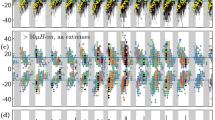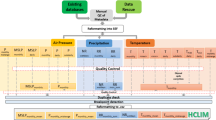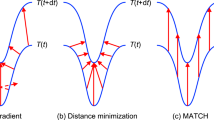Abstract
The historical association of time with the rotation of Earth has meant that Coordinated Universal Time (UTC) closely follows this rotation1. Because the rotation rate is not constant, UTC contains discontinuities (leap seconds), which complicates its use in computer networks2. Since 1972, all UTC discontinuities have required that a leap second be added3. Here we show that increased melting of ice in Greenland and Antarctica, measured by satellite gravity4,5, has decreased the angular velocity of Earth more rapidly than before. Removing this effect from the observed angular velocity shows that since 1972, the angular velocity of the liquid core of Earth has been decreasing at a constant rate that has steadily increased the angular velocity of the rest of the Earth. Extrapolating the trends for the core and other relevant phenomena to predict future Earth orientation shows that UTC as now defined will require a negative discontinuity by 2029. This will pose an unprecedented problem for computer network timing and may require changes in UTC to be made earlier than is planned. If polar ice melting had not recently accelerated, this problem would occur 3 years earlier: global warming is already affecting global timekeeping.
This is a preview of subscription content, access via your institution
Access options
Access Nature and 54 other Nature Portfolio journals
Get Nature+, our best-value online-access subscription
$29.99 / 30 days
cancel any time
Subscribe to this journal
Receive 51 print issues and online access
$199.00 per year
only $3.90 per issue
Buy this article
- Purchase on Springer Link
- Instant access to full article PDF
Prices may be subject to local taxes which are calculated during checkout


Similar content being viewed by others
Data availability
The J2 data are C20LongTerm.txt, downloaded from https://filedrop.csr.utexas.edu/pub/slr/degree_2/ on 25 October 2023. The Earth rotation data are eopc0420.1962-now, downloaded from https://datacenter.iers.org/products/eop/long-term/c04_20/ on 24 October 2023. The atmospheric angular momentum data are from https://datacenter.iers.org/products/geofluids/atmosphere/aam/GGFC2010/AER/, downloaded on 1 February 2023. Other parameters are taken from the papers referenced. Source data are provided with this paper.
Code availability
The code for analysing the residual series, est.noise v.1.2, was downloaded from https://github.com/langbein-usgs on 25 June 2023. The seasonal-adjustment code stl was slightly modified from a version downloaded from https://netlib.org/a/ in June 2008.
References
McCarthy, D. D. & Seidelmann, P. K. Time: From Earth Rotation to Atomic Physics (Cambridge Univ. Press, 2018).
Levine, J., Tavella, P. & Milton, M. Towards a consensus on a continuous coordinated universal time. Metrologia 60, 014001 (2023).
Nelson, R. A. et al. The leap second: its history and possible future. Metrologia 38, 509–529 (2001).
Loomis, B. D., Rachlin, K. E. & Luthcke, S. B. Improved Earth oblateness rate reveals increased ice sheet losses and mass-driven sea level rise. Geophys. Res. Lett. 46, 6910–6917 (2019).
Cheng, M. & Ries, J. C20 and C30 variations from SLR for GRACE/GRACE-FO science applications. J. Geophys. Res. Solid Earth 128, e2022JB025459 (2023).
Lombardi, M. A., Novick, A. N., Neville-Neil, G. & Cooke, B. Accurate, traceable, and verifiable time synchronization for world financial markets. J. Res. Natl Inst. Stand. Technol. 121, 436–463 (2016).
Addomine, M. in A General History of Horology (eds Turner, A. et al.) 137–152 (Oxford Univ. Press, 2022).
Glennie, P. & Thrift, N. Shaping the Day: A History of Timekeeping in England and Wales 1300–1800 (Oxford Univ. Press, 2009).
Kinns, R. Visual time signals for mariners between their introduction and 1947: a new perspective. J. Astron. Hist. Herit. 25, 601–713 (2022).
Ellis, W. Lecture on the Greenwich system of time signals. Horol. J. 7, 85–91, 97–102, 109–114, 121–124 (1865).
Nye, J. & Rooney, D. in A General History of Horology (eds Turner, A. et al.) 495–531 (Oxford Univ. Press, 2022).
Nelson, G. K., Lombardi, M. A. & Okayama, D. T. NIST time and frequency radio stations: Www, WWVH, and WWVB. NIST Special Publication 250-67 (U.S. Department of Commerce, 2005).
Agnew, D. C. Time marks and clock corrections: a century of seismological timekeeping. Seismol. Res. Let. 91, 1417–1429 (2020).
Bullard, E. C. An atomic standard of frequency and time interval: definition of the second of time. Nature 176, 282 (1955).
Guinot, B. & Arias, E. F. Atomic time-keeping from 1955 to the present. Metrologia 42, S20–S30 (2005).
Leschiutta, S. The definition of the ‘atomic’ second. Metrologia 42, S10–S19 (2005).
Munk, W. H. & McDonald, G. The Rotation of the Earth: A Geophysical Discussion (Cambridge Univ. Press, 1960).
Ray, R. D. & Erofeeva, S. Y. Long-period tidal variations in the length of day. J. Geophys. Res. 119, 1498–1509 (2014).
Gross, R. S. in Treatise on Geophysics: Geodesy (ed. Herring, T. A.) 215–261 (Elsevier, 2015).
Haigh, I. D. et al. The tides they are a-changin’: a comprehensive review of past and future nonastronomical changes in tides, their driving mechanisms, and future implications. Rev. Geophys. 58, e2018RG000636 (2020).
Williams, J. G. & Boggs, D. H. Secular tidal changes in lunar orbit and Earth rotation. Celest. Mech. Dyn. Astron. 126, 89–129 (2016).
Whitehouse, P. L. Glacial isostatic adjustment modelling: historical perspectives, recent advances, and future directions. Earth Surf. Dynam. 6, 401–429 (2018).
Peltier, W. R., Wu, P. P.-C., Argus, D. F., Li, T. & Velay-Vitow, J. Glacial isostatic adjustment: physical models and observational constraints. Rep. Prog. Phys. 85, 096801 (2022).
Mitrovica, J. et al. Reconciling past changes in Earth’s rotation with 20th century global sea-level rise: Resolving Munk’s enigma. Sci. Adv. 1, e1500679 (2015).
Kim, A. J. et al. Ice age effects on the satellite-derived \({\dot{J}}_{2}\) datum: mapping the sensitivity to 3D variations in mantle viscosity. Earth Planet. Sci. Lett. 581, 117372 (2022).
Seago, J. H. in Requirements for UTC and Civil Timekeeping on Earth (eds Seago, J. H. et al.) 107–125 (Univelt, American Astronautical Society, 2013).
Cheng, M., Tapley, B. & Ries, J. Deceleration in the Earth’s oblateness. J. Geophys. Res. Solid Earth 118, 740–747 (2013).
Lau, H. C. P. et al. Inferences of mantle viscosity based on ice age data sets: Radial structure. J. Geophys. Res. Solid Earth 121, 6991–7012 (2016).
Mitrovica, J. X. & Peltier, W. R. Present-day secular variations in the zonal harmonics of Earth’s geopotential. J. Geophys. Res. Solid Earth 98, 4509–4526 (1993).
Cox, C. M. & Chao, B. F. Detection of a large-scale mass redistribution in the terrestrial system since 1998. Science 297, 831–833 (2002).
Roy, K. & Peltier, W. R. GRACE era secular trends in Earth rotation parameters: a global scale impact of the global warming process? Geophys. Res. Lett. L10306 (2011).
Fox-Kemper, B. et al. in Climate Change 2021: The Physical Science Basis. Sixth Assessment Report of the Intergovernmental Panel on Climate Change (eds Masson-Delmotte, V. et al.) 1211–1362 (Cambridge Univ. Press, 2021).
Barnoud, A. et al. Revisiting the global mean ocean mass budget over 2005–2020. Ocean Sci. 19, 321–334 (2023).
Wilson, C. The Hill-Brown Theory of the Moon’s Motion: Its Coming-to-Be and Short-Lived Ascendancy (1877–1984) (Springer, 2010).
Kono, M. (ed.) Treatise on Geophysics, Vol. 5: Geomagnetism (series ed. Schubert, G.) (Elsevier, 2015).
Olson, P. (ed.) Treatise on Geophysics, Vol. 8: Core Dynamics (series ed. Schubert, G.) (Elsevier, 2015).
Langbein, J. Methods for rapidly estimating velocity precision from GNSS time series in the presence of temporal correlation: A new method and comparison of existing methods. J. Geophys. Res. Solid Earth 125, e2019JB019132 (2020).
Constable, C. & Constable, S. A grand spectrum of the geomagnetic field. Phys. Earth Planet. Inter. 344, 107090 (2023).
Stephenson, F. R., Morrison, L. V. & Hohenkerk, C. Y. Measurement of the Earth’s rotation: 720 BC to AD 2015. Proc. R. Soc. A 472, 20160404 (2016).
Huber, P. J. Modeling the length of day and extrapolating the rotation of the Earth. J. Geod. 80, 283–303 (2006).
Morrison, L. V., Stephenson, F. R., Hohenkerk, C. Y. & Zawilski, M. Addendum 2020 to ‘Measurement of the Earth’s rotation: 720 BC to AD 2015’. Proc. R. Soc. A 477, 20200776 (2021).
Bell, S. A., Bangert, J. A. & Kaplan, G. H. in The History of Celestial Navigation: Rise of the Royal Observatory and Nautical Almanacs (eds Seidelmann, P. K. & Hohenkerk, C. Y.) 263–311 (Springer, 2020).
Burnicki, M. in Requirements for UTC and Civil Timekeeping on Earth (eds Seago, J. H. et al.) 35–46 (Univelt, American Astronautical Society, 2013).
Seidelmann, P. K. & Seago, J. H. Time scales, their users, and leap seconds. Metrologia 48, S186–S194 (2011).
Seago, J. H., Seaman, R. L., Seidelmann, P. K. & Allen, S. L. (eds) Requirements for UTC and Civil Timekeeping on Earth (Univelt, American Astronautical Society, 2013).
Birth, K. in Law and Time (eds Benyon-Jones, S. M. & Grabham, E.) 196–211 (Routledge, 2018).
Cleveland, R. B., Cleveland, W. S., McRae, J. E. & Terpenning, I. STL: a seasonal-trend decomposition procedure based on loess. J. Off. Stat. 6, 3–73 (1990).
Johnson, H. & Agnew, D. C. Monument motion and measurements of crustal velocities. Geophys. Res. Lett. 22, 2905–2908 (1995).
Acknowledgements
I thank R. Ray, L. Morrison, A. Borsa, J. Mitrovica and M. King for their comments.
Author information
Authors and Affiliations
Corresponding author
Ethics declarations
Competing interests
The author declares no competing interests.
Peer review
Peer review information
Nature thanks Jerry Mitrovica and the other, anonymous, reviewer(s) for their contribution to the peer review of this work.
Additional information
Publisher’s note Springer Nature remains neutral with regard to jurisdictional claims in published maps and institutional affiliations.
Source data
Rights and permissions
Springer Nature or its licensor (e.g. a society or other partner) holds exclusive rights to this article under a publishing agreement with the author(s) or other rightsholder(s); author self-archiving of the accepted manuscript version of this article is solely governed by the terms of such publishing agreement and applicable law.
About this article
Cite this article
Agnew, D.C. A global timekeeping problem postponed by global warming. Nature 628, 333–336 (2024). https://doi.org/10.1038/s41586-024-07170-0
Received:
Accepted:
Published:
Issue Date:
DOI: https://doi.org/10.1038/s41586-024-07170-0
This article is cited by
Comments
By submitting a comment you agree to abide by our Terms and Community Guidelines. If you find something abusive or that does not comply with our terms or guidelines please flag it as inappropriate.



